Uranium Investing in 2025: Tips, Best Stocks & ETFs, and More
Uranium, a key component in nuclear power generation, presents a unique investment avenue. Besides physical uranium, you can invest in uranium stocks, exchange-traded funds (ETFs), and even uranium futures.
But, not without risks!
In this article, we’ll explore the five different methods to invest in uranium, the six leading uranium stocks, and five top uranium ETFs. We’ll also delve into the benefits and potential risks of uranium investing.
You’ll also discover how to invest in an alternative asset like wine through Vinovest.
Further reading
- Check out the 15 Best Alternative Investments to place your bets on in 2024.
- Also, discover why you should consider Investing in Wine Instead of Stocks.
How to Invest in Uranium: 5 Different Methods to Explore

You can consider any of the following methods if you want to start investing in uranium:
1. Uranium Stocks
Uranium stocks represent companies engaged in uranium exploration, mining, and processing. So, investing in them gives you exposure to the uranium industry.
But, you should be aware that uranium prices and stock performance fluctuate based on:
- Rising global energy demands
- Clean energy goals
- Supply constraints
2. Uranium ETFs
Uranium ETFs are investment funds that track the performance of a specific uranium-related index. They provide investors access to companies involved in the uranium industry (mining, refining, or exploration) without investing in individual stocks.
Investing in these ETFs is easy and helps you diversify your portfolio. This also enables investors to potentially capitalize on the growth of the nuclear energy sector.
3. Physical Uranium Investments
Investing in physical uranium provides direct exposure to it's spot price.
But, how do you invest in physical uranium?
You can do it through trusts like Sprott Physical Uranium Trust or companies like Yellow Cake PLC, which buy and hold physical uranium.
4. Uranium Futures
Uranium futures are financial contracts that allow investors to buy or sell a specified amount of uranium at a predetermined price in the future. These derivatives are used to hedge against price fluctuations or speculate on price movements.
For instance, the CME Group provides opportunities to trade in uranium 308 (U308) futures.
However, uranium futures are not widely traded on typical commodity exchanges due to the complex and regulated nature of the uranium market.
5. Uranium Royalties
Investing in uranium royalties involves buying a share of the future production or revenues generated by a uranium mine.
Companies like Uranium Royalty Corp. specialize in this. They provide investors with a proportion of profit earned through the uranium asset without the liability of operational and capital costs of mining.
This investment offers potential advantages like:
- Revenue diversification
- Lower risk compared to direct mining operations
- Access to multiple uranium mine projects
Now, let’s look at some of the best uranium stocks you can add to your portfolio.
6 Leading Uranium Stocks to Invest In
The following are the top six options to consider if you wish to invest in uranium stocks:
- Cameco Corp. (NYSE: CCJ)
- Joint Stock Company National GDR (FRA: 0ZQ)
- Ur Energy Inc. (TSE: URE.TO)
- Uranium Energy Corp. (NYSE: UEC)
- NexGen Energy Ltd. (NYSE: NXE)
- Energy Fuels Inc (NYSE: UUUU)
1. Cameco Corp. (NYSE: CCJ)
Cameco Corp. is one of the world's largest publicly traded uranium companies. This Canadian firm is involved in all stages of uranium production — from mining and milling to resource conversion services.

- Forward Dividend & Yield: 0.27%
- Average Volume: 4.4 million
- Market Cap: $14.14 billion
- PE Ratio (TTM): 108.80
- EPS (TTM): 0.30
2. Joint Stock Company National GDR (FRA: 0ZQ)
Joint Stock Company National Atomic Company Kazatomprom (often known as Kazatomprom) is the world's largest producer of uranium.
This firm is based in Kazakhstan, but its GDR (Global Depositary Receipt) uranium stock is listed on the London Stock Exchange. This makes it easily accessible to investors outside of Kazakhstan.
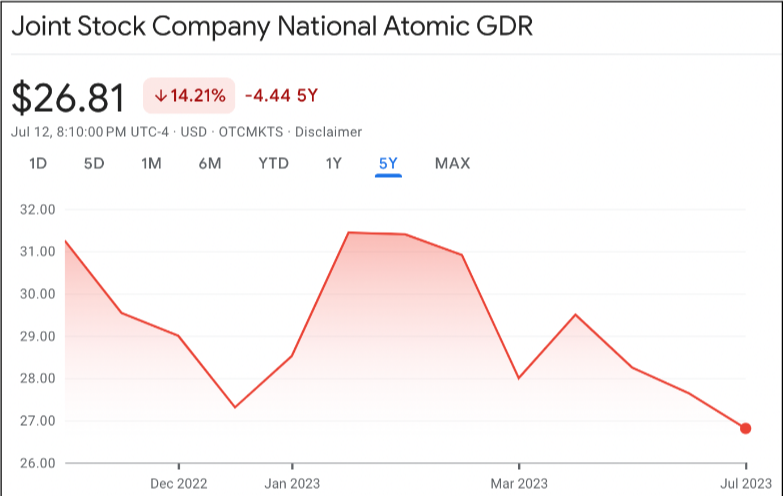
- Forward Dividend & Yield: 7.29%
- Average Volume: 1,273
- Market Cap: $7.17 billion
- PE Ratio (TTM): 6.64
- EPS (TTM): 3.57
3. Ur Energy Inc. (TSE: URE.TO)
Ur Energy Inc. is a uranium mining company based in Wyoming, United States. It’s a leading producer and shipper of uranium for utilities in the US.
Investing in its uranium stock is an easy way to gain access to the US domestic uranium sector.

- Forward Dividend & Yield: N/A
- Average Volume: 47,291
- Market Cap: $360.15 million
- PE Ratio (TTM): N/A
- EPS (TTM): -0.07
4. Uranium Energy Corp. (NYSE: UEC)
Uranium Energy Corp. is a US-based uranium mining and exploration firm.
This uranium company uses in-situ recovery technology to extract the element in Texas and Wyoming. It also has a pipeline of advanced uranium projects.

- Forward Dividend & Yield: N/A
- Average Volume: 5.10 million
- Market Cap: $1.21 billion
- PE Ratio (TTM): 321.00
- EPS (TTM): 0.01
5. NexGen Energy Ltd. (NYSE: NXE)
NexGen Energy Ltd. is a Canadian uranium exploration and development company. It has a critical project in the Athabasca Basin in Saskatchewan — a place known for its high-grade uranium deposits.
The company's primary project, the Rook I project, hosts the Arrow Deposit — one of the world’s largest undeveloped uranium resource regions.
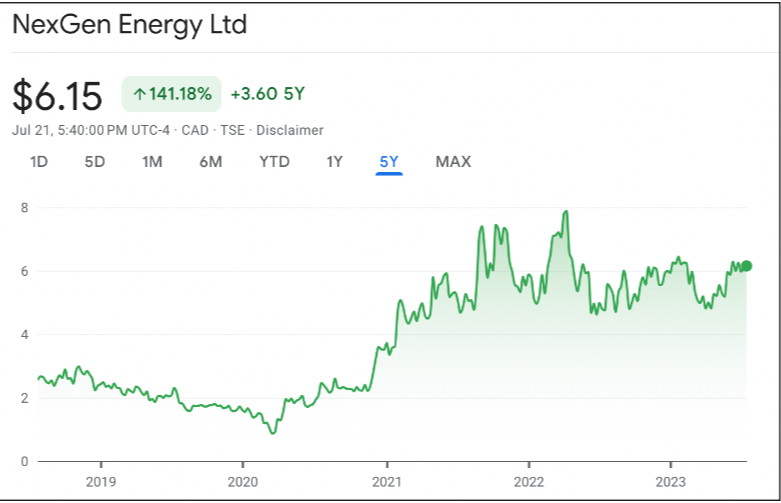
- Forward Dividend & Yield: N/A
- Average Volume: 1.90 million
- Market Cap: $2.26 billion
- PE Ratio (TTM): N/A
- EPS (TTM): -0.06
6. Energy Fuels Inc (NYSE: UUUU)
Energy Fuels Inc. is a leading uranium mining firm based in the United States. This uranium company engages in both conventional and in-situ recovery uranium production.
It’s also a significant vanadium producer and a potential producer of rare earth elements.

- Forward Dividend & Yield: N/A
- Average Volume: 1.59 million
- Market Cap: $945.02 million
- PE Ratio (TTM): 13.86
- EPS (TTM): 0.43
It’s now time to check out a couple of ETFs.
5 Top Uranium ETFs to Diversify Your Portfolio
Here are the five leading uranium ETFs to invest in:
- Global X Uranium ETF (NYSE: URA)
- Sprott Uranium Miners ETF (NYSE: URNM)
- Horizons Global Uranium Index ETF (TSE: HURA)
- VanEck Vectors Uranium+Nuclear Energy ETF (NYSE: NLR)
- ALPS Clean Energy ETF (NYSE: ACES)
1. Global X Uranium ETF (NYSE: URA)
The Global X Uranium ETF tracks the performance of the Solactive Global Uranium & Nuclear Components Total Return Index.
It gives investors access to various companies involved in uranium mining and those engaged in producing nuclear components.
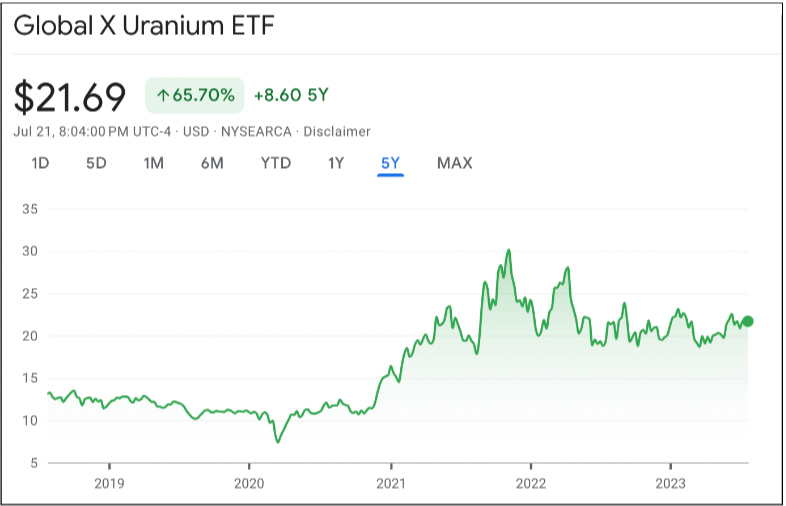
- Net Assets: $1.57 billion
- YTD Daily Total Return: 8.02%
- Net Expense Ratio: 0.69%
- P/E Ratio: 16.41
- Average Volume: 1.32 million
- Yield: 0.23%
2. Sprott Uranium Miners ETF (NYSE: URNM)
The Sprott Uranium Miners ETF tracks the performance of the Sprott Zacks Uranium Miners Index.
It provides investors with access to uranium mining companies. This allows everyone to participate in the uranium market without investing directly in physical uranium or individual uranium mining stocks.
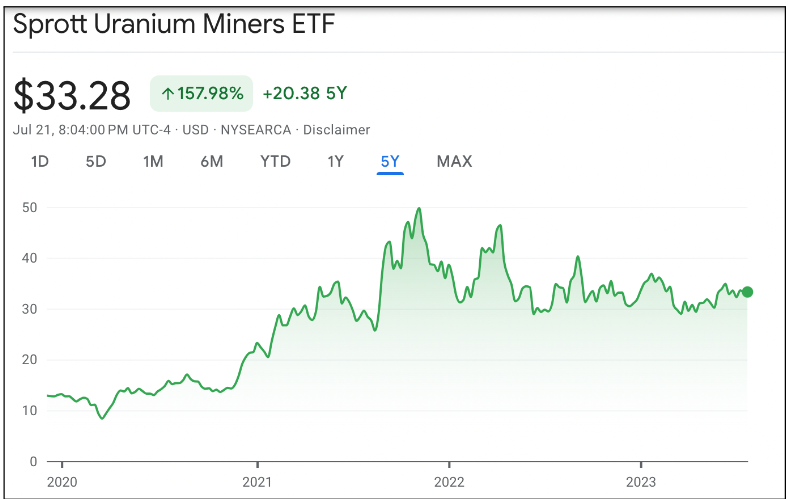
- Net Assets: $913.34 million
- YTD Daily Total Return: 4.85%
- Net Expense Ratio: 0.83%
- P/E Ratio: 17.52
- Average Volume: 269K
- Yield: 0.00%
3. Horizons Global Uranium Index ETF (TSE: HURA)
The Horizons Global Uranium Index ETF tracks the performance of the Solactive Global Uranium Pure-Play Index. It offers investors access to the stocks of global uranium companies.
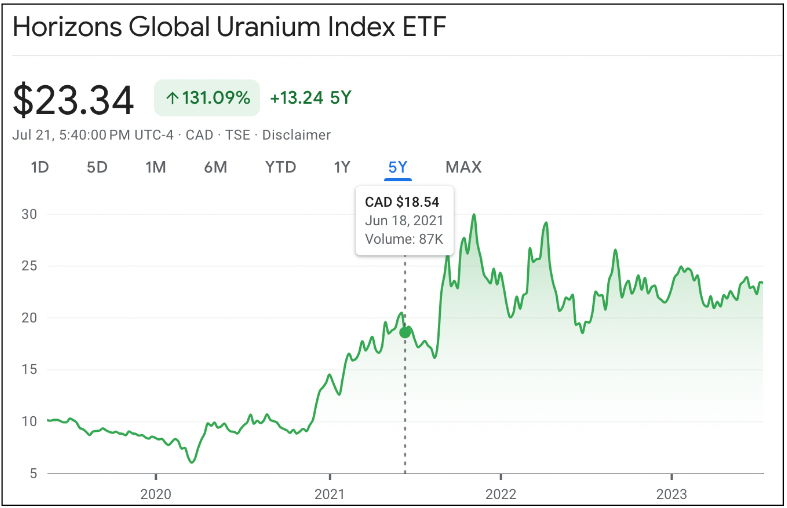
- Net Assets: $50.64 million
- YTD Daily Total Return: 7.06%
- Net Expense Ratio: 0.00%
- P/E Ratio: 15.66
- Average Volume: 1,579
- Yield: 1.32%
4. VanEck Vectors Uranium+Nuclear Energy ETF (NYSE: NLR)
The VanEck Vectors Uranium+Nuclear Energy ETF is designed to track the performance of the MVIS Global Uranium & Nuclear Energy Index. This ETF lets investors put their money into a diversified group of uranium and nuclear energy companies.

- Net Assets: $60.51 million
- YTD Daily Total Return: 9.87%
- Net Expense Ratio: 0.61%
- P/E Ratio: 16.64
- Average Volume: 7,295
- Yield: 1.86%
5. ALPS Clean Energy ETF (NYSE: ACES)
The ALPS Clean Energy ETF tracks the performance of the CIBC Atlas Clean Energy Index.
While not directly a uranium-focused ETF, it can provide access to various companies involved in the nuclear energy sector.

- Net Assets: $487.47 million
- YTD Daily Total Return: 6.74%
- Net Expense Ratio: 0.55%
- P/E Ratio: 18.25
- Average Volume: 87,127
- Yield: 1.12%
Before you dive into uranium investing, it’ll be useful to know the advantages and risks.
4 Benefits of Uranium Investing
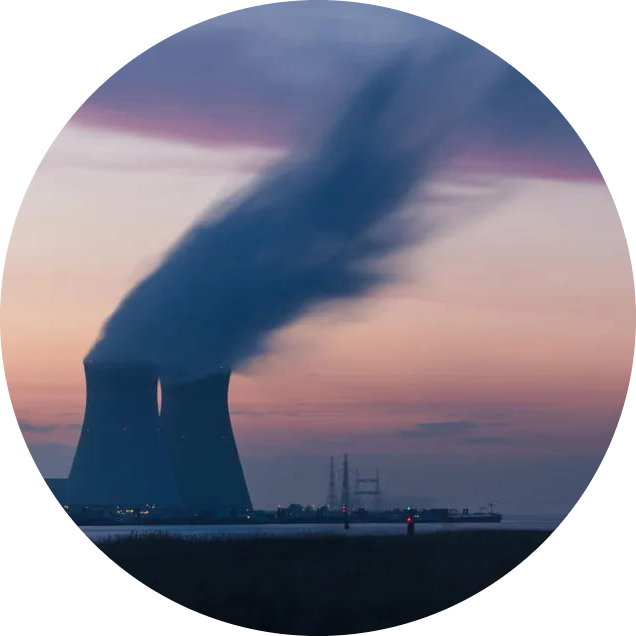
Investing in uranium earns you potential returns, gives you exposure to the clean energy market, and more.
Let’s look at each of these benefits in detail:
1. Potential Returns
Given the right market conditions, investments in a uranium resource can offer substantial returns. For instance, higher uranium prices can significantly boost a company's profitability and increase the returns of those who invest in uranium stocks.
Any supply constraints can also increase uranium prices and potentially boost uranium investments.
2. Growing Transition to Clean Energy
As the world seeks to combat climate change, there's a growing focus on low-carbon energy sources to replace fossil fuel resources.
The good news is that a nuclear power plant emits virtually no greenhouse gases during nuclear fission. This makes uranium or any other form of nuclear energy a crucial player in achieving climate goals.
3. Portfolio Diversification
Investing in uranium allows you to diversify your portfolio and reduce your overall investment risk. Additionally, investing in uranium can be a hedge against volatility in the oil and gas markets.
4. Growing Investments in Emerging Markets
With rising global energy needs and the push for cleaner energy solutions, nuclear power (whose critical raw materials are uranium and uranium oxide) is poised for significant growth.
Nations like China and India are investing heavily in nuclear power plant installations to meet their energy demands and reduce dependence on fossil fuel sources.
While these are some compelling benefits, there are a few risks associated with uranium investing.
3 Potential Risks of Uranium Investing
You should consider these three challenges while investing in uranium assets:
1. Market Volatility
Uranium prices are volatile and can be affected by various factors, including demand and supply changes and regulatory policies. Consequently, uranium or nuclear fuel price fluctuations can directly impact the returns of your uranium assets.
Besides, geopolitical crises in uranium-producing countries can disrupt uranium supply. This can affect global uranium prices and the profitability of uranium companies.
For instance, the US and Europe have largely stopped buying Russian uranium and its other fossil fuels in retaliation to the Ukraine invasion.
2. Environmental and Regulatory Risks
Uranium mining and processing have significant environmental impacts, including:
- Habitat disruption due to nuclear reactor plant setup.
- Overuse of water resources.
- Potential for water and soil contamination from radioactive waste from nuclear reactor plants.
Also, disposing of nuclear fuel waste poses the risk of radioactive pollution.
Because of these environmental and safety concerns, the uranium industry is heavily regulated by bodies like the World Nuclear Association. Changes in regulations or policy can impact uranium mining and production companies. This could also affect your investments.
3. Risks Specific to Different Types of Uranium Investments
Investing in any uranium asset comes with its challenges.
For instance, the risks associated with investing in physical uranium are:
- Limited uranium storage facilities
- Regulatory challenges
- Lack of market liquidity
Meanwhile, if you invest in uranium stocks, ETFs, and futures, be ready for:
- Price volatility
- Regulatory changes
- Sector-specific issues like supply and demand dynamics
Want to invest in another lucrative asset that could override these risks?
Consider fine wine investing.
Investing in Fine Wine: An Attractive Alternative

Fine wine investment returned an impressive 20.54% in 2022, outperforming the S&P 500, which produced an underwhelming -18.11% return. Besides, wine has also been less volatile (3.60%) compared to the S&P 500 stocks (21.16%) during the same year.
Some key benefits of investing in wine are:
- Wine investment has no correlation to market fluctuations and relies solely on supply and demand. Interestingly, the Liv-ex 100 (wine index of the top 100 most traded blue-chip wines) showed a remarkable 32% growth in just the last 5 years.
- Investment-grade wines rarely show sudden price variations and are excellent sources of passive fixed income.
- Online investment platforms like Vinovest offer optimum temperature and pressure-controlled warehouses to store your wine bottles.
- Wine poses a comparatively lesser risk to the environment and is not subject to strict regulations like uranium.
- Certain high-end vintage wines have also been superstars at auction events, delivering astounding results. For example, a 6-liter bottle of the 1992 Screaming Eagle was sold for a jaw-dropping $500,000 at a 2000 Napa Valley auction.
If you’re ready to begin investing in top-notch wines, consider building your portfolio through Vinovest.
Wondering why?
Let’s find out!
Investing in Wine Through Vinovest
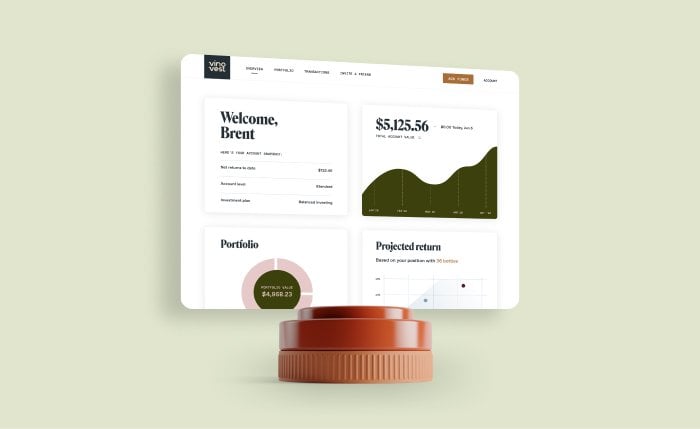
Vinovest is an AI-based wine investment platform that offers a simple and secure way to invest in some of the best wines from around the world. The platform lets you build an enviable portfolio of high-end labels.
The following are some of the advantages of investing through Vinovest:
- Low overall price: Vinovest allows you to buy, store, sell, authenticate, and insure your wine bottles. You can do so for a nominal annual fee of 2.5% (which goes down to 1.9% when your portfolio balance is over $50,000.)
- No intermediaries: Since the platform sources all your wine bottles directly from wineries, auction events, and wine exchanges, you don’t have to deal with intermediaries.
- Hassle-free ownership: Vinovest sources, authenticates, stores, and insures your wine – simplifying the ownership process.
- Expert assistance: Vinovest's expert sommelier team assists you in choosing the best bottles for handsome returns on your portfolio.
Diversify Your Portfolio With Uranium Assets and Wine
Uranium investing offers you an attractive avenue for diversification and potential growth.
However, you need to do careful research and due diligence, and have a clear understanding of the complexities before starting your investment journey.
If you’d prefer a safer alternative without the risks linked with uranium investing, you should consider investing in fine wine through a reliable platform like Vinovest.
Sign up today and start building a profitable portfolio of high-end wines.



